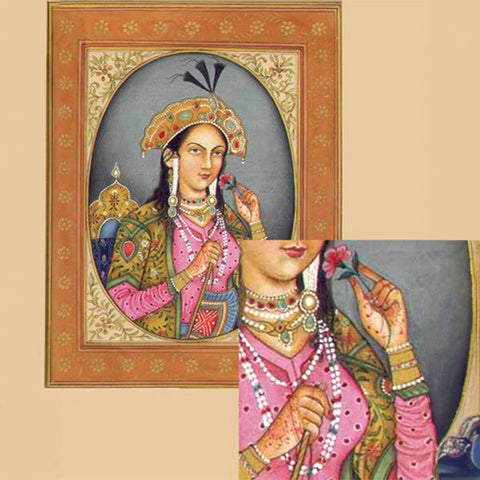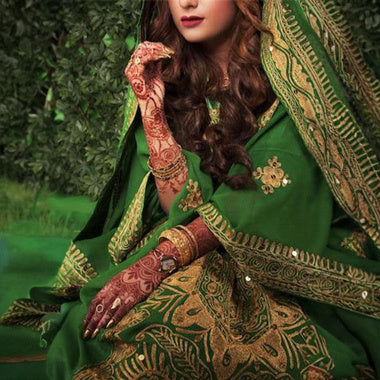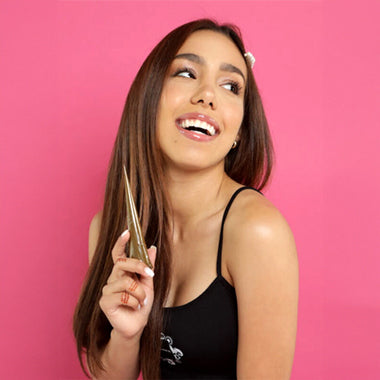Topics
How Long Has Henna Been Used?
How Is Henna Made?
What Traditions Include Henna?
How Do We Use Henna Today?
How To Ensure Henna Is Safe To Use?
How Long Has Henna Been Used?

The use of henna as body art stretches back for centuries, as far as 3000 BCE. Henna has been described in ancient texts, incorporated into wall art, and uncovered on Egyptian mummies. In this portrait, you can see Mumtaz Mahal, wife of the 17th century Mughal Emperor who built the Taj Mahal for her, wearing elaborate henna designs on both hands. The tradition is still alive and well throughout the world.
The practice of henna as a body art developed independently in several cultures, particularly in desert climates. One of the earliest stories of the practical use of henna comes from India, where people found that smearing henna on their hands and feet provided a cooling effect. From there, the practice evolved from a thick covering to intricate patterns that first used twigs to guide the henna paste.
How Is Henna Made?
The desert plant Lawsonia inermis thrives in temperatures up to 120 degrees Fahrenheit with little water. When its leaves are dried and crushed, they releases a compound called lawsone that combines with proteins found in your skin to create a stain. The longer the compound and the proteins stay in contact, the darker the stain will be. In order to make this powder stick to your skin, it is combined with a liquid (like water or tea, depending on which tradition you follow) to create the paste, an acidic component (Iike lemon, lime, apple, or cranberry juice) to break down the plant cells and release the dye, and an essential oil (tea tree, eucalyptus, or lavender work well) to improve the stain’s color and longevity - and because it smells great!
At Mihenna, we source our henna leaves from India, where they are grown organically and sustainably. We create small batches of paste to fill your order using fresh water, our custom blend of eucalyptus, lavender, and tea tree oils, organic sugar, and guar gum to hold all the ingredients together. Learn more about our all-natural henna paste recipe in this blog post or try making your own with our Henna Powder Kit. The lawsone compound will only be active for a short time, but you can help extend its usability by storing the henna paste in the fridge or freezer if you don’t use all of it right away.
What Traditions Include Henna?

In the Middle East (particularly the Arabian peninsula) and India, as well as parts of North Africa, Southeast Asia, and Eastern Europe, henna has long been used as part of body decoration. Different designs emerged from different areas: Morocco is more geometric, Arabic styles use a lot of leaves, and Indian art is floral and fluid. At Mihenna, we've drawn inspiration from a variety of art styles to expand our sticker stencil collection, including:
Henna is commonly applied to a bride’s hands and feet before her marriage. This decoration adds to her overall beauty, and in India, local lore says that the darker a bride’s henna stain on her wedding day, the deeper her husband’s love will be. Pre-wedding henna is most significantly a time for the women of the bride’s family and the groom’s family to come together and get to know each other as they receive their henna designs.
Henna has also long been used to dye hair as well. Depending on the original hair color and ingredients in the paste, dyed hair color can range from bright orange to red to burgundy. Cleopatra even used henna hair dye in ancient Egypt until the day she died.
How Do We Use Henna Today?
The use of henna in body art and hair dye has spread far and wide. Although we do not use it much for it’s cooling or medicinal properties these days, we still find new ways to evolve ancient traditions.
Many people love henna as a temporary tattoo. It doesn’t hurt and wears off after a couple weeks so that you can try new henna designs. Some people will put hours and hours of practice into freehanding henna designs; meanwhile, others prefer to use sticker stencils for a quick and easy application process.
Modern henna artists have also invented new ways to use the paste. You can now find a variety of colors (white is becoming popular in bridal designs) and even glitter henna paste! Before you try out a new type of henna, be sure to read the ingredients and test on a small patch of skin first.
One new way people are using henna to create beauty and bonding is through fake freckles. Henna freckles are an easy way to bring a summer glow to your face without risking sun damage or washing them off every night. Learn how to fake your freckles with Mihenna.
How To Ensure Henna Is Safe To Use?

The only way to know you are getting premium, high-quality henna paste is to buy natural henna. The paste should be thick and reddish brown with an earthy smell. If preservatives have been added to a pre-made paste to make it last longer, they may cause adverse effects to your skin or color quality of the tattoo.
Other types of non-natural henna include “neutral” and “black” henna. Neutral henna is made from a different type of plant and so is not henna at all. Its dyeing properties come from other chemicals added to the paste. Black henna commonly contains an ingredient called para-phenylenediamine (PPD), which the FDA has listed as illegal in the United States. PPD can cause highly allergic reactions that may become life threatening.
For your safety and others, only use natural, organic henna paste. If you have any skin sensitivities, always test out a small amount of even the natural henna before using.
Now with this information you can go out, and be sure you’re making the right decisions and henna tattooing safely. Time for some body art!
